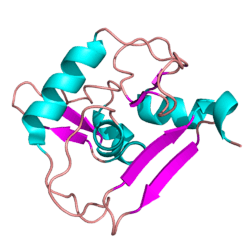PHF6
PHD finger protein 6 is a protein that in humans is encoded by the PHF6 gene.[5][6]
This gene is a member of the plant homeodomain (PHD)-like finger (PHF) family. It encodes a protein with two PHD-type zinc finger domains, indicating a potential role in transcriptional regulation, that localizes to the nucleolus. Mutations affecting the coding region of this gene or the splicing of the transcript have been associated with Börjeson-Forssman-Lehmann syndrome (BFLS), a disorder characterized by mental retardation, epilepsy, hypogonadism, hypometabolism, obesity, swelling of subcutaneous tissue of the face, narrow palpebral fissures, and large ears. Alternate transcriptional splice variants, encoding different isoforms, have been characterized.[6]
References
- 1 2 3 GRCh38: Ensembl release 89: ENSG00000156531 - Ensembl, May 2017
- 1 2 3 GRCm38: Ensembl release 89: ENSMUSG00000025626 - Ensembl, May 2017
- ↑ "Human PubMed Reference:".
- ↑ "Mouse PubMed Reference:".
- ↑ Lower KM, Turner G, Kerr BA, Mathews KD, Shaw MA, Gedeon AK, Schelley S, Hoyme HE, White SM, Delatycki MB, Lampe AK, Clayton-Smith J, Stewart H, van Ravenswaay CM, de Vries BB, Cox B, Grompe M, Ross S, Thomas P, Mulley JC, Gecz J (Nov 2002). "Mutations in PHF6 are associated with Borjeson-Forssman-Lehmann syndrome". Nat Genet. 32 (4): 661–665. doi:10.1038/ng1040. PMID 12415272.
- 1 2 "Entrez Gene: PHF6 PHD finger protein 6".
Further reading
- Nagase T, Nakayama M, Nakajima D, et al. (2001). "Prediction of the coding sequences of unidentified human genes. XX. The complete sequences of 100 new cDNA clones from brain which code for large proteins in vitro". DNA Res. 8 (2): 85–95. doi:10.1093/dnares/8.2.85. PMID 11347906.
- Strausberg RL, Feingold EA, Grouse LH, et al. (2003). "Generation and initial analysis of more than 15,000 full-length human and mouse cDNA sequences". Proc. Natl. Acad. Sci. U.S.A. 99 (26): 16899–16903. doi:10.1073/pnas.242603899. PMC 139241. PMID 12477932.
- Baumstark A, Lower KM, Sinkus A, et al. (2003). "Novel PHF6 mutation p.D333del causes Börjeson-Forssman-Lehmann syndrome". J. Med. Genet. 40 (4): 50e–50. doi:10.1136/jmg.40.4.e50. PMC 1735415. PMID 12676923.
- Dattani MT (2004). "Borjeson-Forssman-Lehmann syndrome: a novel pituitary phenotype due to mutation in a novel gene". J. Pediatr. Endocrinol. Metab. 16 (9): 1207–9. doi:10.1515/jpem.2003.16.9.1207. PMID 14714741.
- Birrell G, Lampe A, Richmond S, et al. (2004). "Borjeson-Forssman-Lehmann syndrome and multiple pituitary hormone deficiency". J. Pediatr. Endocrinol. Metab. 16 (9): 1295–300. PMID 14714754.
- Turner G, Lower KM, White SM, et al. (2004). "The clinical picture of the Börjeson-Forssman-Lehmann syndrome in males and heterozygous females with PHF6 mutations". Clin. Genet. 65 (3): 226–232. doi:10.1111/j.0009-9163.2004.00215.x. PMID 14756673.
- Lower KM, Solders G, Bondeson ML, et al. (2005). "1024C> T (R342X) is a recurrent PHF6 mutation also found in the original Börjeson-Forssman-Lehmann syndrome family". Eur. J. Hum. Genet. 12 (10): 787–789. doi:10.1038/sj.ejhg.5201228. PMID 15241480.
- Vallée D, Chevrier E, Graham GE, et al. (2005). "A novel PHF6 mutation results in enhanced exon skipping and mild Börjeson-Forssman-Lehmann syndrome". J. Med. Genet. 41 (10): 778–783. doi:10.1136/jmg.2004.020370. PMC 1735599. PMID 15466013.
- Gerhard DS, Wagner L, Feingold EA, et al. (2004). "The status, quality, and expansion of the NIH full-length cDNA project: the Mammalian Gene Collection (MGC)". Genome Res. 14 (10B): 2121–2127. doi:10.1101/gr.2596504. PMC 528928. PMID 15489334.
- Andersen JS, Lam YW, Leung AK, et al. (2005). "Nucleolar proteome dynamics". Nature. 433 (7021): 77–83. doi:10.1038/nature03207. PMID 15635413.
- Ross MT, Grafham DV, Coffey AJ, et al. (2005). "The DNA sequence of the human X chromosome". Nature. 434 (7031): 325–337. doi:10.1038/nature03440. PMC 2665286. PMID 15772651.
- Crawford J, Lower KM, Hennekam RC, et al. (2006). "Mutation screening in Borjeson-Forssman-Lehmann syndrome: identification of a novel de novo PHF6 mutation in a female patient". J. Med. Genet. 43 (3): 238–243. doi:10.1136/jmg.2005.033084. PMC 2563250. PMID 15994862.
- Olsen JV, Blagoev B, Gnad F, et al. (2006). "Global, in vivo, and site-specific phosphorylation dynamics in signaling networks". Cell. 127 (3): 635–648. doi:10.1016/j.cell.2006.09.026. PMID 17081983.
External links
- PHF6+protein,+human at the US National Library of Medicine Medical Subject Headings (MeSH)
This article incorporates text from the United States National Library of Medicine, which is in the public domain.





